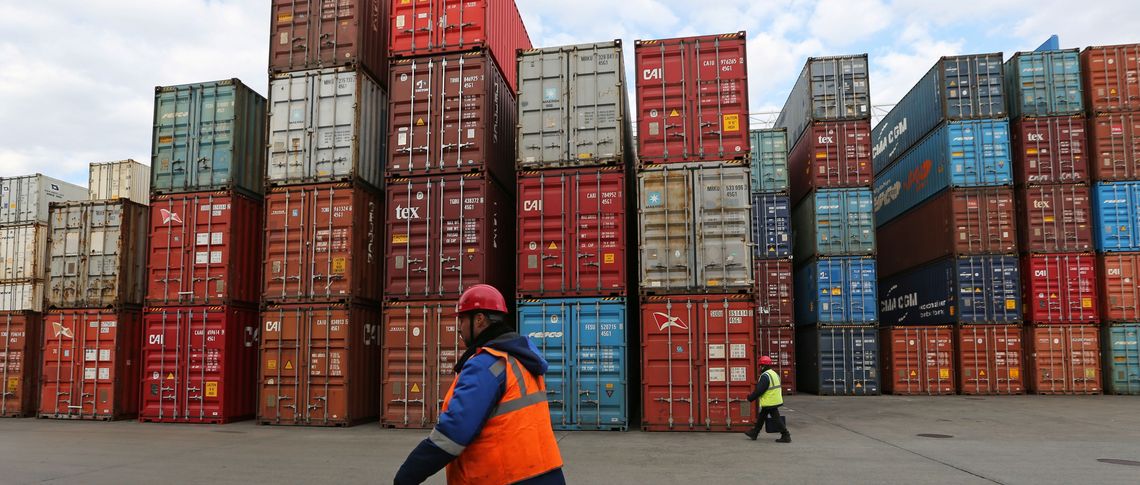There is no doubt that economic forecasting is a hard job – especially when it's about predicting a possible recession. Evidence shows that there is a very big chance that a recession will be missed, or that the predicted recession will not actually happen. The latter was famously described by Nobel laureate Paul Samuelson, when he spoke of ‘predicting nine of the past five recessions’.
This was exactly the case when it came to forecasting the economic outlook for Central Asian and South Caucasian countries after the Russian invasion of Ukraine. Back in March-April 2022, almost any economist would have predicted that these states, so strongly tied to Russia at a level that almost synchronised their economic cycles, had a gloomy economic future given the deep crisis expected for Russia.
External trade with Russia accounted for around 30 per cent of Armenia’s and 25 per cent of Kyrgyzstan’s overall trade.
These economic ties include, amongst others, trade, investments, remittances and foreign exchange (FX) markets. Remittances from Russia, on average, accounted for 30 per cent of Tajikistan’s and 25 per cent of Kyrgizstan’s GDP in the last decade. While external trade with Russia accounted for around 30 per cent of Armenia’s and 25 per cent of Kyrgyzstan’s overall trade. Other countries with strong economic ties to Russia are Kazakhstan, Uzbekistan, Georgia and Azerbaijan. These ties created a synchronised economic cycle for the region, which was clearly visible in the spillovers of the 2014 shock (‘first-round’-sanctions and oil shock) when almost all countries of the region experienced growth slowdowns and pressures on their FX markets.
This is the reason why, since 24 February 2022, economic uncertainty has been high not only for Russia but also for the wider region. Attempting somehow to outline the risks for the Armenian economy, my colleague and I published an article in which the possible developments were quantified with different scenarios. They painted, overall, quite a gloomy picture: a decline in money transfers, exports, investments and GDP. Although we emphasised that some positive developments were possible, these were harder to project and also seen as minor.
Proving the forecasters wrong
International organisations followed the same line of thought. The IMF, for instance, was projecting regional economic growth to significantly slow down in the region. And yet, it turned out that some countries actually recorded economic growth rates which are even notable globally. How could the forecasters be so far from reality, and what was their mistake?
The first mistake came in the form of assumptions made regarding the Russian economy. Although a deep recession was predicted for Russia (from 8 to 15 per cent decline in GDP), the Russian economy eventually declined only by 2.1 per cent. The biggest mistake, however, was to assume that the channels through which the Russian economy impacts other countries would not be impacted, even though it was clear that Russia was experiencing an unprecedented shock, becoming the most sanctioned country ever and at a very rapid pace. Given the small size of some of these impacted economies, three macro-critical effects for the countries of the region resulted;
Net money transfers from Russia to Armenia, Georgia and Azerbaijan increased more than fivefold in 2022, while Tajikistan and Uzbekistan saw a doubling.
After Western export bans to Russia, Russian imports declined by around 40 per cent but recovered to pre-war level already in November 2022. This recovery came through shifting import sources to other countries like China, but also through parallel imports by third countries such as Turkey, Kazakhstan, Kyrgyzstan, Armenia and Georgia. As a result, consumer goods like smartphones, washing machines and refrigerators, freezers, passenger vehicles and vehicle parts are still reaching Russia, albeit with some price premiums that are charged on the alternative routes and generate additional income for companies acting as intermediaries.
Restraining Russia’s opportunities for doing business internationally (including the IT and finance sector), sanctions have been incentivising qualified workforce to flee the country, being hosted partly by countries in the region such as Armenia, Georgia, Kazakhstan and Uzbekistan, amounting to 50 to 150 thousand people for each country. This is putting pressure on local housing markets, with spiking rents and prices, and also on the prices of the services sector.
Lastly, the countries around Russia also experienced a relatively big capital inflow from the country, which was in some part accompanying the movement of people and companies, and in another part influenced by the search for a ‘safe place’ from the sanction regimes that also targets the Russian banking sector. Net money transfers from Russia to Armenia, Georgia and Azerbaijan increased more than fivefold in 2022, while Tajikistan and Uzbekistan saw a doubling. This put pressure on the FX markets of these countries, resulting in the appreciation of national currencies. The strongest appreciation was recorded for the Armenian dram – 18.5 per cent in 2022, followed by the Georgian lari with 13.3 per cent.
The flipside of the coin
Most of these economies are small in size and, so these channels are a significant growth boost. For example, the exports from Armenia to Russia increased by $1.6 bn, which represents only 0.5 per cent of Russia’s overall imports in 2021 but ensured an increase of more than 50 per cent in Armenia’s exports.
But there is a flipside to this coin. As the countries from the region are benefiting from Russian inflows and paralleled trade, vulnerabilities are quickly building up;
The positive economic effects felt led to a phenomenon called the ‘Dutch disease’ by economists, where the economy becomes more ‘lazy’ and starts to lose its more productive sectors.
First of all, although the probability of the West imposing secondary sanctions on paralleled trade is assessed to be low, these countries are exposing themselves more and more to the Russian economy, which is undergoing major challenges and transformations.
Secondly, price pressures caused by the influx of human capital to these countries are a challenge too, particularly in a high-inflation environment. This creates social pressures and increases inequality due to higher incomes in some sectors (housing, accommodation and other services) and increasing prices with stagnating real incomes in other sectors (such as agriculture or industry).
Finally, the positive economic effects felt led to a phenomenon called the ‘Dutch disease’ by economists, where the economy becomes more ‘lazy’ and starts to lose its more productive sectors. This happens due to an appreciated exchange rate, which makes goods produced in the country more expensive abroad, leading domestic companies to lose their external markets. Moreover, labour starts to move to the booming ‘lazy’ sectors, creating more long-term problems. This issue is visible, for example, in the Armenian IT sector, which has been rapidly emerging, supported by a talented workforce and price competitiveness.
The countries of the region, as well as the Western countries imposing the sanctions, have some homework to do.
Although the governments of Central Asian and South Caucasian countries are trying to manage such risks, some face hard choices. For example, Armenia banned the export of dual-use goods, but re-exports of goods like smartphones or cars are not expected to halt, given the common economic area (Eurasian Economic Union) shared with Russia. And the inflationary pressures from additional demand pushed the central bank to tighten monetary policy and willonly carefully loosen it again, even after breaching the lower bound of the inflation target.
No easier to manage are the ‘laziness’ problems. The exchange rate appreciation is already a reality, so governments try to stimulate the ‘productive’ sectors such as manufacturing and IT. But these types of policies are costly both financially and socially.
Hence, the countries of the region, as well as the Western countries imposing the sanctions, have some homework to do. The former should be careful while weighing short-term benefits against long-term costs, primarily to protect themselves from the risks that could damage their economies for a longer period. And the latter should support them on this road with all the tools available to them.






